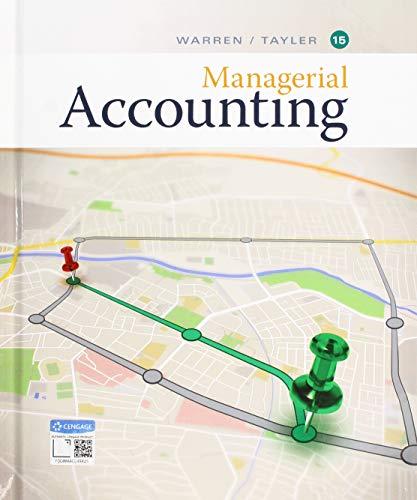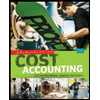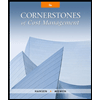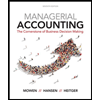
Lean accounting
Dashboard Inc. manufactures and assembles automobile instrument panels for both eCar Motors and Greenville Motors. The process consists of a lean product cell for each customer’s instrument assembly. The data that follow concern only the eCar lean cell.
For the year, Dashboard Inc. budgeted the following costs for the eCar production cell:

Dashboard Inc. plans 2,000 hours of production for the eCar cell for the year. The materials cost is $240 per instrument assembly. Each assembly requires 24 minutes of cell assembly time. There was no April 1 inventory for either Raw and In Process Inventory or Finished Goods Inventory. The following summary events took place in the eCar cell during April:
- A. Electronic parts and wiring were purchased to produce 450 instrument assemblies in April.
- B. Conversion costs were applied for the production of 400 units in April.
- C. 380 units were started, completed, and transferred to finished goods in April.
- D. 350 units were shipped to customers at a price of $800 per unit.
Instructions
- 1. Determine the budgeted cell conversion cost per hour.
- 2. Determine the budgeted cell conversion cost per unit.
- 3. Journalize the summary transactions (a) through (d).
- 4. Determine the ending balance in Raw and In Process Inventory and Finished Goods Inventory.
- 5. How does the accounting in a lean environment differ from traditional accounting?
1.
Calculate the conversion cost per hour for the budgeted cell.
Explanation of Solution
Lean Manufacturing: Lean manufacturing aims at reducing the cost and minimizing the waste involved in the production, in order to optimize the value for the product or the service.
Lean Accounting: Lean accounting refers to the accounting standards that support the concepts of lean manufacturing. They record and reflect the transactions done to assist lean manufacturing.
Conversion Cost: The cost involved in the conversion of the raw material into the processed product is known as the conversion cost.
Calculate the conversion cost per hour for the budgeted cell.
Hence, the conversion cost per hour for the budgeted cell is $700 per hour.
2.
Calculate the conversion cost per unit for the budgeted cell.
Explanation of Solution
Calculate the conversion cost per unit for the budgeted cell.
Hence, the conversion cost per hour for the budgeted cell is $280 per unit.
3.
Journalize the given transactions.
Explanation of Solution
- A. Materials purchased to produce 450 units.
| Date | Account Title | Debit ($) | Credit ($) |
| June | Raw and In-Process Inventory (1) | $108,000 | |
| Accounts payable | $108,000 | ||
| (Purchase of goods on account) |
Table (1)
- • Raw materials are an asset, which is increased. Hence debit the raw and in-process inventory with $108,000.
- • Accounts payable is a liability, which is increased; hence credit the accounts payable account with $108,000.
Working Note:
(1) Calculate the amount of goods purchased.
The cost of raw and in-process inventory is $108,000.
- B. Conversion cost applied to 400 units.
| Date | Account Title | Debit ($) | Credit ($) |
| June | Raw and In-Process Inventory (2) | $112,000 | |
| Conversion Costs | $112,000 | ||
| (The conversion costs involved in the production) |
Table (2)
- • Value is added to the raw materials, increases the asset. Hence debit the raw and in-process inventory with $112,000.
- • Conversion cost is an expense which reduces the stockholder's equity; hence credit the conversion cost account with $112,000.
Working Note:
(2) Calculate the amount value added.
The cost of conversion for 400 units is $112,000.
- C. Completed the production of 380 units.
| Date | Account Title | Debit ($) | Credit ($) |
| June | Finished Goods Inventory (3) | $197,600 | |
| Raw and In-Process Inventory | $197,600 | ||
| (The completion of 380 units placed in finished goods) |
Table (3)
- • Value is added to the finished goods, increases the asset. Hence debit the finished goods inventory with $197,600.
- • Raw materials are an asset, which is decreased. Hence credit the raw and in-process inventory with $197,600.
Working Note:
(3) Calculate the amount value added.
The cost of conversion for 380 units is $197,600.
- D. Sold 350 units.
| Date | Account Title | Debit ($) | Credit ($) |
| June | Accounts receivable | $280,000 | |
| Sales (4) | $280,000 | ||
| (Sold 350 units) |
Table (4)
- • Accounts receivable, which is an asset, is increased. Hence debit the accounts receivable account with $280,000.
- • Sales are revenue generated, which increases stockholder's equity. Hence credit the sales with $280,000.
Working Note:
(4) Calculate the amount value added.
The sales price for 350 units is $280,000.
- E. Record the cost of goods sold.
| Date | Account Title | Debit ($) | Credit ($) |
| June | Cost of Goods sold (5) | $182,000 | |
| Finished Goods Inventory | $182,000 | ||
| (The cost of goods sold is recorded) |
Table (5)
- • Cost of goods sold is an asset, which is decreased. Hence debit the cost of goods sold with $182,000.
- • Finished goods inventory is an asset, which is decreased. Hence credit the finished goods inventory with $182,000.
Working Note:
(5) Calculate the amount value added.
The cost of goods sold for 350 units is $182,000.
4.
Calculate the closing balance for Raw in Process Inventory and Finished Goods inventory.
Explanation of Solution
- 1. Calculate the closing balance for Raw in Process Inventory.
Hence, the closing balance for Raw in Process Inventory is $22,400.
- 2. Calculate the closing balance for finished goods inventory.
Hence, the closing balance for finished goods inventory is $15,600.
5.
Explain the difference between the lean accounting and traditional accounting.
Explanation of Solution
The lean accounting is created to support the lean philosophy; hence it is obviously different from the traditional accounting in the ways mentioned below.
- • There are very few work in-process control points in lean accounting, whereas there are many control points in the traditional accounting. This reduces the number of transactions involved in the Lean accounting.
- ■ In Lean accounting the raw materials and work in progress are shown together as raw and in process inventory, hence unlike traditional accounting there are very few transactions shown.
- ■ In lean manufacturing, the direct labor cost is a part of the indirect labor cost. Hence, the direct labor cost and indirect labor cost are shown together in lean manufacturing whereas in traditional accounting they are shown separately under various heads.
These are some of the differences between the lean accounting and traditional accounting.
Want to see more full solutions like this?
Chapter 13 Solutions
Managerial Accounting
- Krouse Company produces two products, forged putter heads and laminated putter heads, which are sold through specialty golf shops. The company is in the process of developing itsoperating budget for the coming year. Selected data regarding the companys two products areas follows: Manufacturing overhead is applied to units using direct labor hours. Variable manufacturing overhead Ls projected to be 25,000, and fixed manufacturing overhead is expected to be15,000. The estimated cost to produce one unit of the laminated putter head is: a. 42. b. 46. c. 52. d. 62.arrow_forwardJoyT Company manufactures Maxi Dolls for sale in toy stores. In planning for this year, JoyT estimated variable factory overhead of 600,000 and fixed factory overhead of 400,000. JoyT uses a standard costing system, and factory overhead is allocated to units produced using standard direct labor hours. The level of activity budgeted for this year was 10,000 direct labor hours, and JoyT used 10,300 actual direct labor hours. Based on the output accomplished during this year, 9,900 standard direct labor hours should have been used. Actual variable factory overhead was 596,000, and actual fixed factory overhead was 410,000 for the year. Based on this information, the variable factory overhead controllable variance for JoyT for this year was: a. 24,000 unfavorable. b. 2,000 unfavorable. c. 4,000 favorable. d. 22,000 favorable.arrow_forwardSalisbury Bottle Company manufactures plastic two-liter bottles for the beverage industry. The cost standards per 100 two-liter bottles are as follows: At the beginning of March, Salisburys management planned to produce 500,000 bottles. The actual number of bottles produced for March was 525,000 bottles. The actual costs for March of the current year were as follows: a. Prepare the March manufacturing standard cost budget (direct labor, direct materials, and factory overhead) for Salisbury, assuming planned production. b. Prepare a budget performance report for manufacturing costs, showing the total cost variances for direct materials, direct labor, and factory overhead for March. c. Interpret the budget performance report.arrow_forward
- Jacson Company produces two brands of a popular pain medication: regular strength and extra strength. Regular strength is produced in tablet form, and extra strength is produced in capsule form. All direct materials needed for each batch are requisitioned at the start. The work orders for two batches of the products are shown below, along with some associated cost information: In the Mixing Department, conversion costs are applied on the basis of direct labor hours. Budgeted conversion costs for the department for the year were 60,000 for direct labor and 190,000 for overhead. Budgeted direct labor hours were 5,000. It takes one minute of labor time to mix the ingredients needed for a 100-unit bottle (for either product). In the Bottling Department, conversion costs are applied on the basis of machine hours. Budgeted conversion costs for the department for the year were 400,000. Budgeted machine hours were 20,000. It takes one-half minute of machine time to fill a bottle of 100 units. Required: 1. What are the conversion costs applied in the Mixing Department for each batch? The Bottling Department? 2. Calculate the cost per bottle for the regular and extra strength pain medications. 3. Prepare the journal entries that record the costs of the 12,000 regular strength batch as it moves through the various operations. 4. Suppose that the direct materials are requisitioned by each department as needed for a batch. For the 12,000 regular strength batch, direct materials are requisitioned for the Mixing and Bottling departments. Assume that the amount of cost is split evenly between the two departments. How will this change the journal entries made in Requirement 3?arrow_forwardAdam Corporation manufactures computer tables and has the following budgeted indirect manufacturing cost information for the next year: If Adam uses the step-down (sequential) method, beginning with the Maintenance Department, to allocate support department costs to production departments, the total overhead (rounded to the nearest dollar) for the Machining Department to allocate to its products would be: a. 407,500. b. 422,750. c. 442,053. d. 445,000.arrow_forwardBox Springs. Inc., makes two sizes of box springs: queen and king. The direct material for the queen is $35 per unit and $55 is used in direct labor, while the direct material for the king is $55 per unit, and the labor cost is $70 per unit. Box Springs estimates it will make 4,300 queens and 3,000 kings in the next year. It estimates the overhead for each cost pool and cost driver activities as follows: How much does each unit cost to manufacture?arrow_forward
- Johnston Company cleans and applies powder coat paint to metal items on a job-order basis. Johnston has budgeted the following amounts for various overhead categories in the coming year. In the coming year, Johnston expects to powder coat 120,000 units. Each unit takes 1.3 direct labor hours. Johnston has found that supplies and gas (used to run the drying ovensall units pass through the drying ovens after powder coat paint is applied) tend to vary with the number of units produced. All other overhead categories are considered to be fixed. (Round all overhead rates to the nearest cent.) Required: 1. Calculate the number of direct labor hours Johnston must budget for the coming year. Calculate the variable overhead rate. Calculate the total fixed overhead for the coming year. 2. Prepare an overhead budget for Johnston for the coming year. Show the total variable overhead, total fixed overhead, and total overhead. Calculate the fixed overhead rate and the total overhead rate (rounded to the nearest cent). 3. What if Johnston had expected to make 118,000 units next year? Assume that the variable overhead per unit does not change and the total fixed overhead amounts do not change. Calculate the new budgeted direct labor hours and prepare a new overhead budget. Calculate the fixed overhead rate and the total overhead rate (rounded to the nearest cent).arrow_forwardCarsen Company produces handcrafted pottery that uses two inputs: materials and labor. During the past quarter, 24,000 units were produced, requiring 96,000 pounds of materials and 48,000 hours of labor. An engineering efficiency study commissioned by the local university revealed that Carsen can produce the same 24,000 units of output using either of the following two combinations of inputs: The cost of materials is 8 per pound; the cost of labor is 12 per hour. Required: 1. Compute the output-input ratio for each input of Combination F1. Does this represent a productivity improvement over the current use of inputs? What is the total dollar value of the improvement? Classify this as a technical or an allocative efficiency improvement. 2. Compute the output-input ratio for each input of Combination F2. Does this represent a productivity improvement over the current use of inputs? Now, compare these ratios to those of Combination F1. What has happened? 3. Compute the cost of producing 24,000 units of output using Combination F1. Compare this cost to the cost using Combination F2. Does moving from Combination F1 to Combination F2 represent a productivity improvement? Explain.arrow_forwardBox Springs, Inc., makes two sizes of box springs: twin and double. The direct material for the twin is $25 per unit and $40 s used in direct labor, while the direct material for the double is $40 per unit, and the labor cost is $50 per unit. Box Springs estimates it will make 5,000 twins and 9,000 doubles in the next year. It estimates the overhead for each cost pool and cost driver activities as follows: How much does each unit cost to manufacture?arrow_forward
- Firenza Company manufactures specialty tools to customer order. Budgeted overhead for the coming year is: Previously, Sanjay Bhatt, Firenza Companys controller, had applied overhead on the basis of machine hours. Expected machine hours for the coming year are 50,000. Sanjay has been reading about activity-based costing, and he wonders whether or not it might offer some advantages to his company. He decided that appropriate drivers for overhead activities are purchase orders for purchasing, number of setups for setup cost, engineering hours for engineering cost, and machine hours for other. Budgeted amounts for these drivers are 5,000 purchase orders, 500 setups, and 2,500 engineering hours. Sanjay has been asked to prepare bids for two jobs with the following information: The typical bid price includes a 40 percent markup over full manufacturing cost. Required: 1. Calculate a plantwide rate for Firenza Company based on machine hours. What is the bid price of each job using this rate? 2. Calculate activity rates for the four overhead activities. What is the bid price of each job using these rates? 3. Which bids are more accurate? Why?arrow_forwardDouglas Davis, controller for Marston, Inc., prepared the following budget for manufacturing costs at two different levels of activity for 20X1: During 20X1, Marston worked a total of 80,000 direct labor hours, used 250,000 machine hours, made 32,000 moves, and performed 120 batch inspections. The following actual costs were incurred: Marston applies overhead using rates based on direct labor hours, machine hours, number of moves, and number of batches. The second level of activity (the right column in the preceding table) is the practical level of activity (the available activity for resources acquired in advance of usage) and is used to compute predetermined overhead pool rates. Required: 1. Prepare a performance report for Marstons manufacturing costs in the current year. 2. Assume that one of the products produced by Marston is budgeted to use 10,000 direct labor hours, 15,000 machine hours, and 500 moves and will be produced in five batches. A total of 10,000 units will be produced during the year. Calculate the budgeted unit manufacturing cost. 3. One of Marstons managers said the following: Budgeting at the activity level makes a lot of sense. It really helps us manage costs better. But the previous budget really needs to provide more detailed information. For example, I know that the moving materials activity involves the use of forklifts and operators, and this information is lost when only the total cost of the activity for various levels of output is reported. We have four forklifts, each capable of providing 10,000 moves per year. We lease these forklifts for five years, at 10,000 per year. Furthermore, for our two shifts, we need up to eight operators if we run all four forklifts. Each operator is paid a salary of 30,000 per year. Also, I know that fuel costs about 0.25 per move. Assuming that these are the only three items, expand the detail of the flexible budget for moving materials to reveal the cost of these three resource items for 20,000 moves and 40,000 moves, respectively. Based on these comments, explain how this additional information can help Marston better manage its costs. (Especially consider how activity-based budgeting may provide useful information for non-value-added activities.)arrow_forwardJillian Manufacturing Inc. manufactures a single product and uses a standard cost system. The factory overhead is applied on the basis of direct labor hours. A condensed version of the company’s flexible budget follows: The product requires 3 lb of materials at a standard cost of $5 per pound and 2 hours of direct labor at a standard cost of $10 per hour. For the current year, the company planned to operate at the level of 6,250 direct labor hours and to produce 3,125 units of product. Actual production and costs for the year follow: Required: For the current year, compute the factory overhead rate that will be used for production. Show the variable and fixed components that make up the total predetermined rate to be used. Prepare a standard cost card for the product. Show the individual elements of the overhead rate as well as the total rate. Compute (a) standard hours allowed for production and (b) under- or overapplied factory overhead for the year. Determine the reason for any under- or overapplied factory overhead for the year by computing all variances, using each of the following methods: Two-variance method Three-variance method (appendix) Four-variance method (appendix)arrow_forward
 Managerial AccountingAccountingISBN:9781337912020Author:Carl Warren, Ph.d. Cma William B. TaylerPublisher:South-Western College Pub
Managerial AccountingAccountingISBN:9781337912020Author:Carl Warren, Ph.d. Cma William B. TaylerPublisher:South-Western College Pub Principles of Cost AccountingAccountingISBN:9781305087408Author:Edward J. Vanderbeck, Maria R. MitchellPublisher:Cengage Learning
Principles of Cost AccountingAccountingISBN:9781305087408Author:Edward J. Vanderbeck, Maria R. MitchellPublisher:Cengage Learning Cornerstones of Cost Management (Cornerstones Ser...AccountingISBN:9781305970663Author:Don R. Hansen, Maryanne M. MowenPublisher:Cengage Learning
Cornerstones of Cost Management (Cornerstones Ser...AccountingISBN:9781305970663Author:Don R. Hansen, Maryanne M. MowenPublisher:Cengage Learning- Principles of Accounting Volume 2AccountingISBN:9781947172609Author:OpenStaxPublisher:OpenStax College
 Financial And Managerial AccountingAccountingISBN:9781337902663Author:WARREN, Carl S.Publisher:Cengage Learning,
Financial And Managerial AccountingAccountingISBN:9781337902663Author:WARREN, Carl S.Publisher:Cengage Learning, Managerial Accounting: The Cornerstone of Busines...AccountingISBN:9781337115773Author:Maryanne M. Mowen, Don R. Hansen, Dan L. HeitgerPublisher:Cengage Learning
Managerial Accounting: The Cornerstone of Busines...AccountingISBN:9781337115773Author:Maryanne M. Mowen, Don R. Hansen, Dan L. HeitgerPublisher:Cengage Learning





